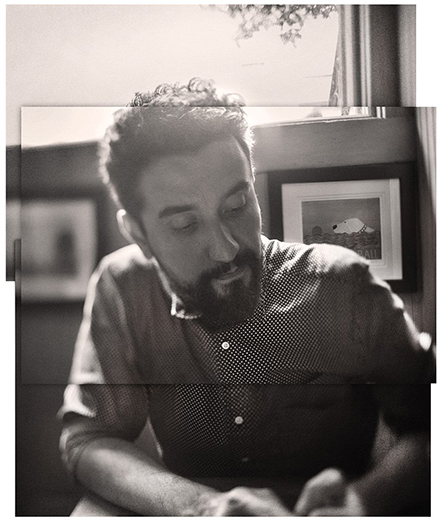Interview: Gustavo Marx
Written by Fernanda, Posted in INTERVIEWS
Brazilian photographer Gustavo Marx is the first interviewee to be featured on the blog this year.
Gustavo is someone to be admired not only for his work and talent but also for how genuine his passion is for his family, job, and values.
This could not have been a better choice for the first interview to be published on the blog in 2014.
Gustavo, thank you for taking time out of your busy schedule, and thank you for sharing with 917 Diaries a little bit of your professional and personal life here in NY!
Has your passion for photography always been a part of you since you were young? Tell us about your relationship with it.
Honestly, I don’t know. I don’t think I found myself right away. My father has always liked photography and always had cameras around, so I used to play with them. But I don’t know if that’s exactly what started it all. I have always liked photography, but just like most people do, you know? When I was studying at the old FUMA [Fundação Mineira de Arte in Belo Horizonte, Brazil], a good friend offered me a job. She knew I liked photography, and I was lucky her husband was just starting a car magazine and needed a photographer. They used to test cars, and the first one was with a car that belonged to F1 driver Ayrton Senna. The test took place in Belo Horizonte, and I ended up taking the pictures. I didn’t even have my own equipment; they had to lend me everything. I hated every photo I took, and that’s when I decided I needed to study photography. In 1995, I took a leave of absence from college and came to the US for the first time. I came to visit a friend who lived in NY and stayed at his place for a while. I started taking classes at SVA [School of Visual Arts], focusing on subjects that interested me, like fashion and studio photography. I spent a year in NY and then returned to Brazil.
How did things go after you returned to Brazil?
Right after I got back, I had the chance to photograph a model in Belo Horizonte. I was assisting a photographer, and out of nowhere, she started talking to me. She liked me, and we quickly became friends. She asked me to photograph her next test. This model, Adriana Piccinini, invested a lot of money for us to travel to a beach for four days. After that shoot, I started photographing several models in Belo Horizonte, thanks to her recommendations. Not long after, I shot my first fashion campaign for a local brand – I think it was Eliana Queiroz – and things evolved from there.
How do you see your growth as a photographer after this first campaign?
It all came down to pursuing the things I liked and falling in love with what great photographers had done. And, of course, a lot of research. I started translating what top photographers were doing at the time into something I thought would look good. I never copied them. I know it’s a cliché to say this, but I always drew inspiration from the works I admired. At first, when I was still testing models, they used to bring me books and things to look at. This first girl I tested – Adriana Piccinini – brought me two Richard Avedon books and said, “I want something just like this.” And I said, “No way! This is Avedon, and I can’t do something like this.” But she insisted I try to do something similar. So, trying to make things similar, without copying, changed the way I saw things as my career evolved.
You won a few awards before moving back to NY six years ago…
I spent some time in Brazil building my career, establishing myself in Belo Horizonte and other cities. In 2008, I received awards in NY and Paris for a portrait of model Bruna Velho. I always tell this story as a turning point in my career. I was in São Paulo photographing the finalists for the Brazilian Ford Models contest, and this girl mesmerized me with her story, so I ended up making her portrait. There’s not a lot of fashion in that portrait, but when I saw the picture, it hit me. It was the first time I realized how powerful a photo could be while I was editing it. I recognized how strong that image was, so I submitted it to a few contests, and I ended up winning all of them [Bruna Velho by Gustavo Marx – 2007 IPA, International Photo Awards, and Prix de La Photographie Paris]. I also sent a few other photos to those contests. I ended up winning first place in the fashion and beauty categories here in NY. I felt very proud, especially when you consider that Michael Thompson won 3rd place in the same competition with a photo of Gisele Bündchen. I came to NY to receive the awards, met with a few agents, and signed with one of them. That’s when I thought, “I have an agent; this is the time to move to NY.” I had to convince my wife, and six years ago, we moved here. Two years ago, we had a little boy and now have a little American boy in the house. And that’s how it all happened and I ended up moving back to NY.
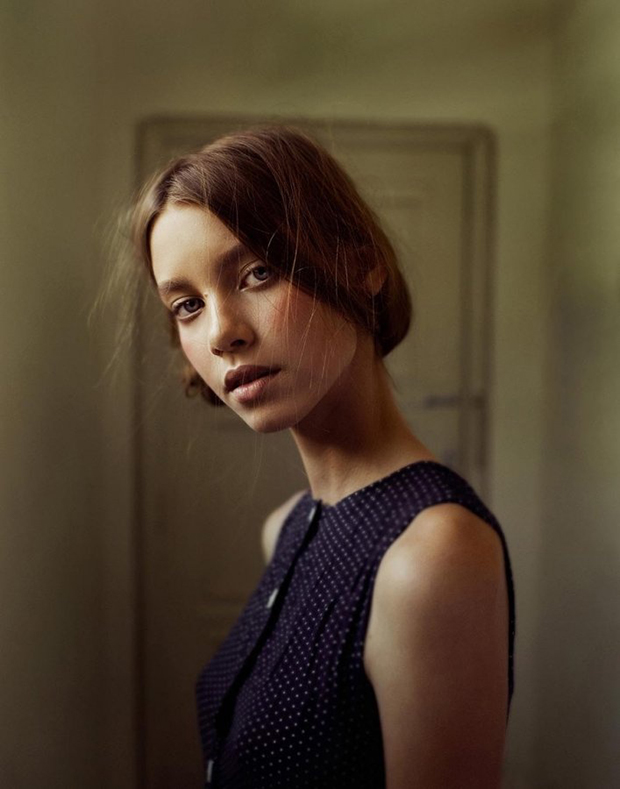
Bruna Velho by Gustavo Marx, 2007
How would you describe your style? I know you really enjoy working with natural light and are well-known for this approach.
When I first came to NY, in ’96, I ended up studying studio lighting. I had an Italian teacher – Mario Calafeto – who always said the only way he liked to recreate sunlight in a studio was through a single source of light. I ended up doing the same thing when working in a studio. The studio environment, however, breaks the spontaneity that can only be achieved when photographing outdoors, in natural sunlight. So, I started thinking: if I can have access to the real thing, why not take advantage of it? I realized my eye was quite influenced by things I admired in art, like paintings that captured a poetic moment from a character’s daily routine. That’s how I started developing my own way of capturing these whimsical moments, while still making them commercially appealing—after all, I needed to pay the bills. Wow, now I went too far… LOL!
I absolutely love when something like this happens during an interview! I don’t want it to sound or look like a stiff conversation, something mechanical. You share your feelings in a different way, and that’s when special things can emerge—things I didn’t even expect to be mentioned at first. And that is definitely the best part of it all!
Anyway, I’m mentioning this because [the use of sunlight] used to happen a lot, but I think it’s been changing a bit. I’m going through a phase where I’m enjoying—even more than ever—the process of constructing and building an image. Maybe I have a better idea of what I really want now. When you work with the unexpected, you need to have a very sharp eye and sensitivity to see and capture those special moments. I think I’m in a phase where I want to be able to develop the stories I want to tell a little further. I’ve been focusing more on this over the past year and a half. This is something very important to me when being part of a campaign. Everything needs to be pre-defined, and I feel like this has been happening more often in my career.
Which campaigns have had the deepest impact on you?
I can get very emotionally attached because I give my all to every project. Everyone who works with me knows that. But I think I’ve had some very special ones. I shot four campaigns for Adidas Y-3, and that meant a lot to me. The way the American market respects you once you’re part of it made me very happy. Having the chance to photograph in NY really left a mark; it left a mark on my heart and gave me a sense of accomplishment for being part of those very large campaigns. I’ve also had the opportunity to work on some big advertising campaigns in the US, outside of fashion, and they were incredible learning experiences. Just to give you an idea of the scale, one project required 50 days of pre-production meetings, with conference calls involving 5-10 people every 10 days. After those 50 days, there were 20 consecutive days of shooting, where I was directing 10-50 actors.
The first project of that magnitude was a pharmaceutical campaign for one of the largest – if not the largest – pharmaceutical companies in the world, based in Germany. Managing an account like that, which involved five different advertising agencies, five art directors, one creative director, and 40 actors – all on set with me – was a huge achievement. Being able to make it all happen was incredible because you go through so much, talking to so many people under immense pressure. I had never done anything on such a large scale until then. So, I think those were the major turning points in my career here in NY.
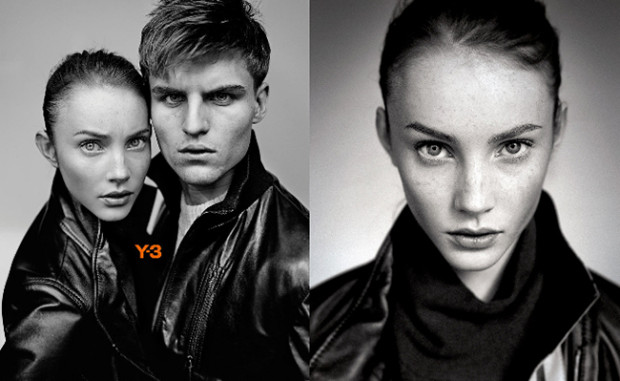
Adidas Y3 Fall 2011 by Gustavo Marx
Any other recent projects you would like to highlight?
I worked on DTA’s Summer campaign and did a lot of projects in Brazil. I shot for Mabel Magalhães in Belo Horizonte, 18 pages for the September issue of Elle Brazil, and Nana Kokaev in BH—one I always enjoy doing. I also shot the cover of the third book in The Selection series. Last year, I won a very important advertising award [Commarts – 2012 – Book Cover Category] here in the U.S. for the first book cover. I just finished shooting the third one. The book is about to be turned into a TV show. They shot the pilot over a year ago, and The Selection by Kiera Cass is a New York Times best-seller. It’s a book for young adults, and now it’s gaining even more momentum since a major studio is set to turn it into a show.
I also shot some editorials for Dossier Journal, which I absolutely love. One of them was a fashion editorial that was great to shoot and took place at a stud farm in New Jersey, all styled by the incredible Emily Jenkins.
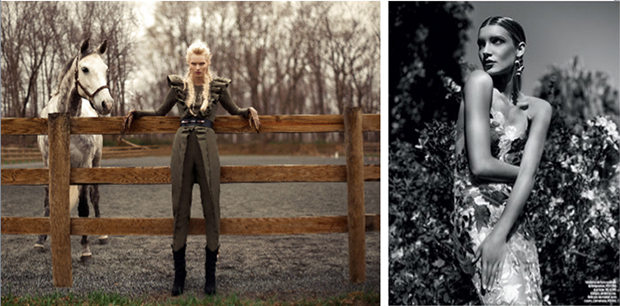
Editorial for Dossier Journal (left) | B&W photo published in Elle Brazil, September 2013 issue (right)
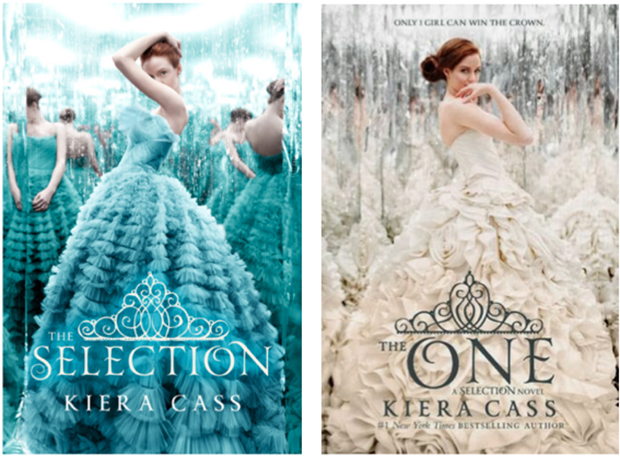
Award-winning cover (left) for New York Times best-seller The Selection by Kiera Cass
Who are the photographers that inspire you?
To me, Guy Bourdin is the greatest, my all-time favorite. He used to play with photography in such a whimsical way. Sometimes I come across things that, at first, I didn’t know were made by him and think, “Wow, this is so Guy Bourdin,” assuming the photo was shot recently because it seems so current, so strong and colorful. Then I realize it was actually one of his own photos, but it was shot 60 years ago! I also really admire Edward Steichen, who was a mentor to Avedon. I discovered his career at ICP [International Center of Photography], during an exhibit about his work, with videos showing how he used to direct the models and build his photos. He was brilliant! The way he constructed images in the studio, using a camera that only allowed him to take one photo every 40 minutes, was incredible. And then, to see how much he influenced Avedon, whom I admire so much. He created several iconic magazine covers here in America in the ’40s and ’50s. He’s definitely someone worth researching.
Is there a newcomer, a young talent, that you have been keeping an eye on?
This is a very hard question. I think I’ve seen so many new photographers who ended up disappearing from the scene that I don’t remember them all. From the younger generation, I admire Sebastian Kim and Serge Leblon. I also really like Guy Aroch. It’s interesting; there are specific characteristics in my work that remind me of his, so I guess that’s where my admiration comes from. These are some of the people I admire who are relatively newer to the market.
I couldn’t possibly talk about photography without asking about your favorite galleries here in NY. Which ones would you list as your “must-see” places for anyone who’s a photography enthusiast?
You can’t miss Gagosian. It’s a place I always visit because I always see incredible works by both well-known artists and people I’ve never heard of. Honestly, I’d rather not mention others because I might not remember their exact names. This is awful, but after living in NY for so long and having such a hectic schedule, you end up going to the ones you already like, just to save time. So, I’d say this one is my favorite. I also enjoy going to museums to see photo exhibits. I love the Whitney Museum, and the classics like the MET, Guggenheim, and MoMA… But Whitney is my favorite here in NY.
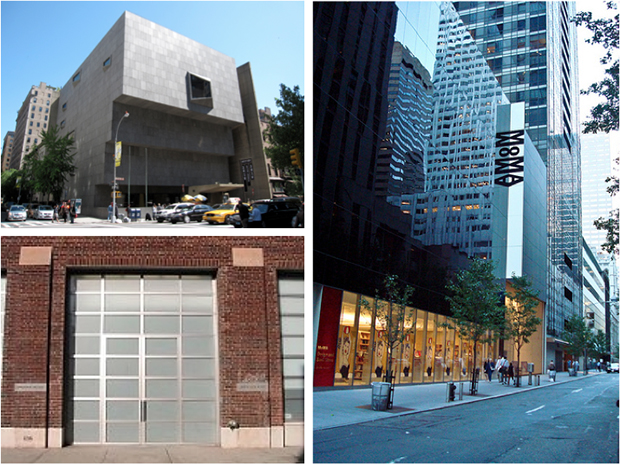
Left: Whitney Museum and one of the entries of the Gagosian Gallery in Chelsea Right: MoMa Museum
How is your connection with NY? Some people can’t stand the pace while others really enjoy it…
Professionally speaking, I really like it. I think the city can be quite demanding in a way no other place is—maybe São Paulo, but in a different way. I think I was born to be challenged, and I enjoy it. I believe in the speed at which everything happens in this city. NY can really destroy someone if you’re not prepared for it. Over time, many people feel like it’s time to leave the city. NY makes it quite clear when that time has come because it can start treating you very harshly! I’m lucky because it has treated me very well. I always say that whenever I’m feeling down, I just need to go out, take a walk, look at the tall buildings, the people around me, and feel the energy that emanates from the city. The cliché in the song—that the streets will make you feel better—totally works for me. Some people embrace that energy, and others don’t. I’m one of the people who do, and I love it. That said, I also know I’m one of those who love the city but will eventually leave. I love NY, but I’m 40 years old, and I’m sure that 10 years from now my energy won’t be the same. Very cliché, I know, but I’m certain I want to end up somewhere in a house where I can just stare at boundless space—no mess, no confusion—unlike this crazy city NY is, which I love so much at the moment.
Do you see yourself moving back to Brazil or moving to the suburbs?
I would love to go somewhere else in the world, neither Brazil nor Connecticut, for example. I don’t have anything against those places, but I would love to experience somewhere different. I’ve already achieved the dream of living here, and my priority now is to live peacefully with my family, especially after my son was born. Everything changed. It’s one of those things everyone talks about, and I see how true it is every day—I just want to live in peace. My biggest goal right now is to find peace, the true essence of things, and to be with my family. I just don’t know exactly where I’ll be able to find that.
Do you think your son has been influencing your perception and sensibility toward your work?
I think so. Without him even realizing it, he’s made me seek the true essence of things. I don’t know why, but I’ve been thinking about it a lot. He’s this little person who is always and completely true to his spirit. It’s such a crazy thing! And because this little boy was born, and is 100% honest at all times, it’s made me seek real truth in the things I do and photograph. I try not to waste time with people and things that don’t add anything to my life, and I think this is reflecting in my work, making it even more honest.
What are your favorite places to visit in NY?
I really enjoy walking around Chelsea and the High Line. I simply adore it, which is why I asked for us to meet here [Chelsea Market], because this is a place I truly love. I also love the East Village and crossing the Brooklyn Bridge alone when I just want to feel the city’s energy. I have my favorite coffee shops, too. I love the espresso at Chelsea Market, and Gimme Coffee in Soho. There are several places I like, such as Café Gitane in Soho and McNally Jackson, a bookstore/coffee shop on Prince St., which is a great place to read a book or magazine while enjoying your coffee. Beacon Theatre is a classic for shows. I love the upper part of Central Park, near the northern end. Since I live nearby, I’ve come to know it well. The kids’ playgrounds, the tracks, and the deeper parts of the park are just so beautiful. The entrance at 100th Street, for example, has a very nice playground that leads to a beautiful lake that not everyone knows about. I love running around the Jackie Onassis Reservoir. Every time I take my son there, he’s so delighted to be there. Aside from the lakes and the tranquility of Central Park, the people walking around, each in their own world—it brings such peace! And, of course, there are the museums I’ve already mentioned.
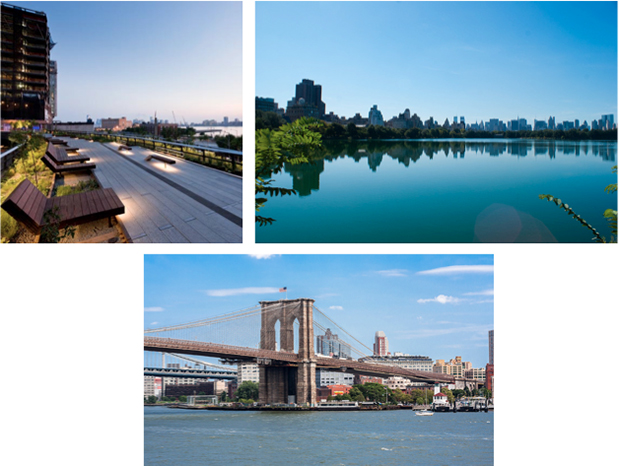
High Line, Central Park Resevoir, Brooklyn Bridge
What about your favorite restaurants?
There’s this sushi place, which is my favorite in NY, located in Park Slope, Brooklyn—Jpan Sushi. It’s an exceptional place with great prices; it’s on 5th Avenue. On the same avenue, there’s a place called Bonnie’s Grill, which is one of my favorite burger spots. There’s also Island Burger on 9th Avenue, between 51st and 52nd, I think. I loved it! It’s unbelievable how they have over 50 types of burgers—it’s simply incredible! Then there are the classics like Pastis, which is always good and has a great vibe. Eataly has one of the best ice creams in the city, but nothing beats L’Arte del Gelato here at Chelsea Market. I love mixing the pistachio gelato with the frutti di bosco. I also love Grey Dog, which has a few locations in the city—this one was “love at first bite” [LOL]. The first one I visited was at Union Square, on University Place. It’s a spot I truly recommend!
What are your weekend getaways?
I wish I had more getaways. I feel like they’re becoming a bit repetitive, so I’d say the Catskills is a great option. Woodstock is also fantastic. There’s this beach I like to visit during the week whenever I have the chance, located close to Jones Beach. One part of the beach is closed to the general public because of bird studies and observation. I’ll never forget one time I went there, and they stopped me at the entrance, saying I couldn’t pass because it was bird observation time. The only way I could cross was if I had observation equipment. So, I opened my trunk and showed them two suitcases full of photography equipment, and they immediately let me through. It’s a deserted, quiet, amazing place! Just an hour away from NY.
Also, whenever I get the chance, I like to visit the Dia:Beacon museum. I take the Metro-North and enjoy the gorgeous view on the way upstate. It feels like I’m in a movie—it’s something that makes me appreciate constantly moving around the city. I love it so much.
![]()
Catskills, Dia:Beacon entrance, and Jones Beach in NY
You obviously travel a lot for work. Is there a place that pleasantly surprised you during one of your work trips?
Anguilla, where I traveled to shoot an editorial for Condé Nast Brides Magazine. But this is something that changed a lot after the American economic crisis. Budgets for shoots were drastically cut, and now things are being produced closer to “home.” All the traveling glamour you used to see has been reduced. Not that it doesn’t still exist, but it’s no longer what it used to be. Anyway, I went to this Caribbean island, Anguilla, and it had an unbelievable natural beauty that I don’t think I’d ever seen before. Besides the beautiful, clear waters, we stayed at this great hotel—Viceroy Anguilla—and stayed in one of their gorgeous villas. The place is truly amazing.
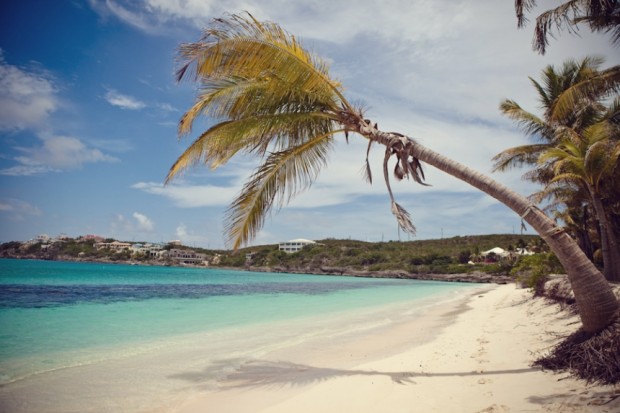
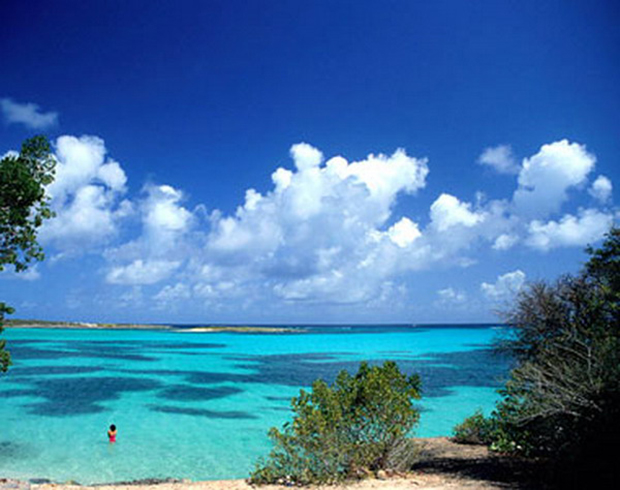
Anguilla beaches in the Caribbean
Is there a place you haven’t been to yet that you wish you could explore as a photographer?
Japan. I’m not sure if I want to photograph anything there, but I think I would. I don’t know why, but I’ve been attracted to Japan ever since I was five years old. It’s definitely a place I hope to visit within the next two years.
What do you recommend to those interested in becoming a professional photographer?
For those hoping to work in the fashion field, I think the first thing they need is to develop a stronger sense of critical thinking. People aren’t being critical enough these days. I always say that it took me 10 years to call myself an actual photographer. Before that, I used to say I was an assistant. I know things have changed and are happening much faster now; photographic processing used to be very time-consuming. Developing an image, for example, used to take much longer. That, alone, shows how much harder it was to call yourself a professional in the field. I don’t see newcomers having the proper self-criticism that they should. So, this would be the first thing I’d point out: constantly work on developing a sharp sense of self-criticism and a good eye. Research quality content, not only online but also in books and magazines. Look up the important names in photography in the field you want to pursue.
The second thing would be: if you want to become a fashion photographer, you really need the experience of assisting a fashion photographer before anything else. That’s how you’ll learn how the business around and behind your job works. I didn’t assist much during my career, and I think it took me longer to get to where I wanted to be because I didn’t have that experience.
How do you see all these technological developments – in both equipment and apps – influencing photography?
I love how technology seamlessly integrates into my everyday tasks. I like how everything has become more democratic. I know photographers who only have a professional Instagram and others who only have a personal one. I don’t see anything wrong with that. It’s just another means to an end; you have galleries, press, computers… and you also have Instagram. I don’t think it’s a bad thing at all.
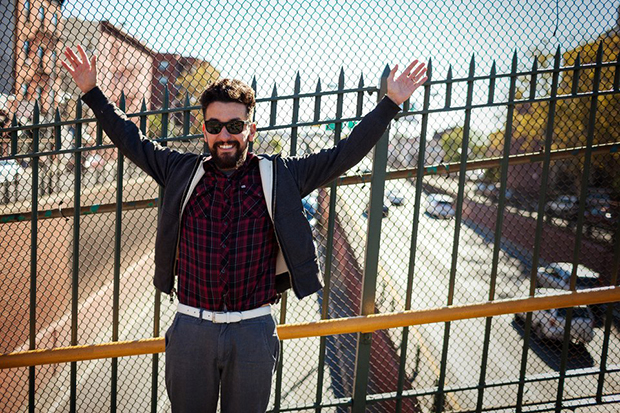
Gustavo Marx by photographer Gustavo Romanelli
For more information on Gustavo Marx’s work, check: www.gusmarx.com
Gustavo’s Black and White opening photo was taken by Mark Tucker.
Adidas Anguilla Bruna Velho Coven Dia:Beacon Elle Brasil Elle Magazine Ford Models FUMAX Gisele Bündchen Gustavo Marx Gustavo Romanelli Guy Bourdin International Photo Award Kiera Cass Moda NY photography Prix de La Photographie Paris Richard Avedon SVA The Selection Y-3

